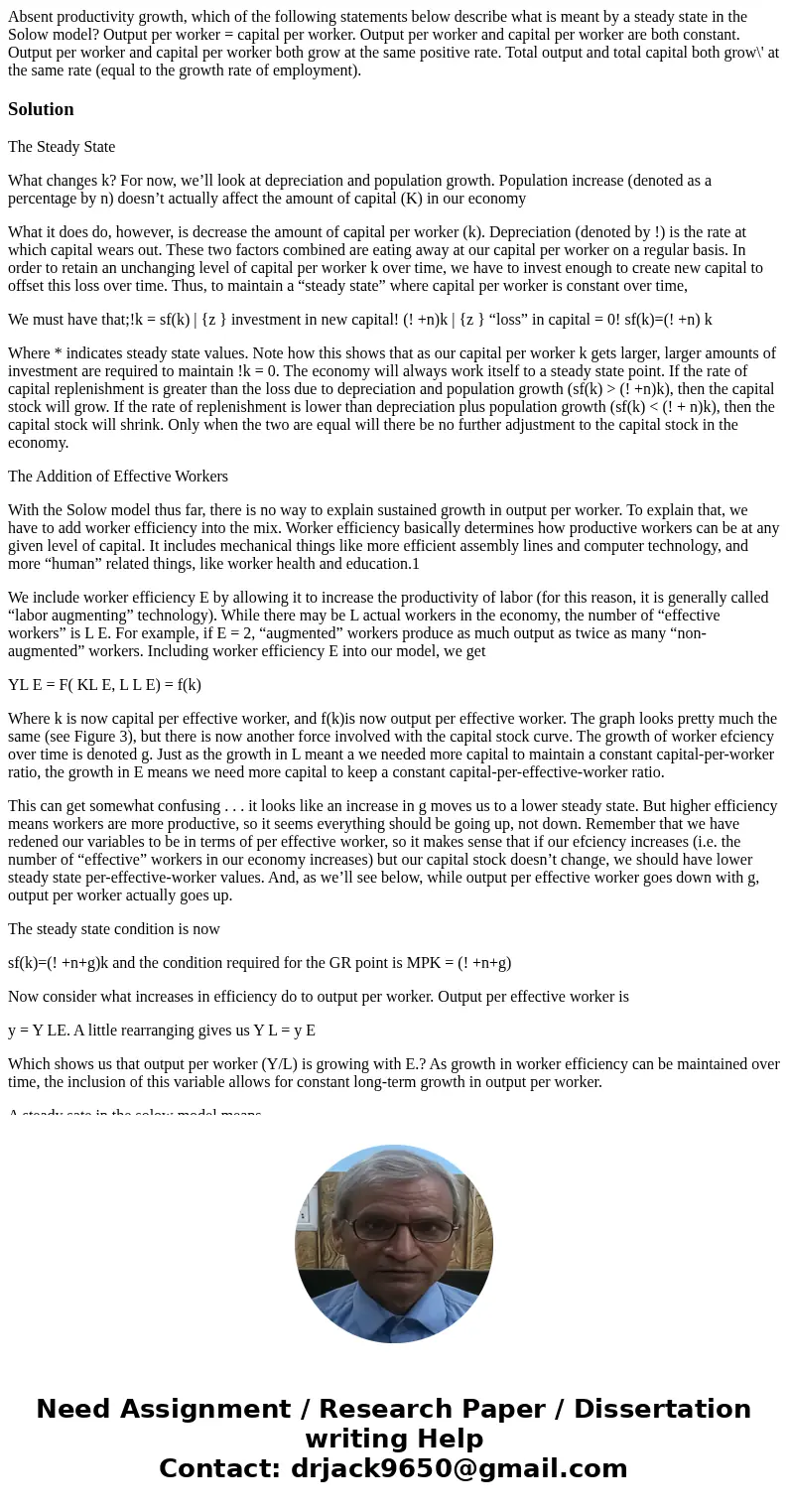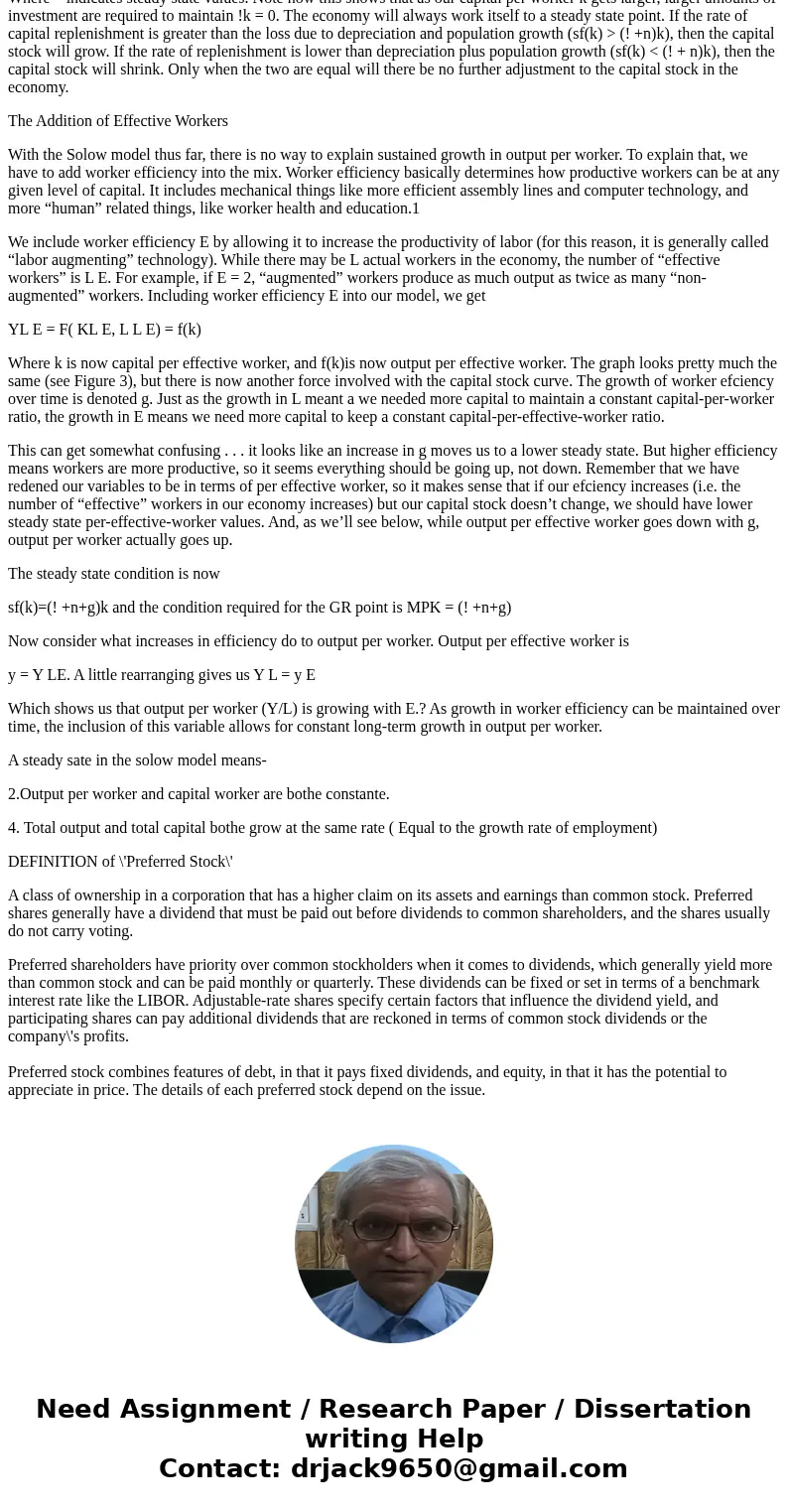Absent productivity growth which of the following statements
Solution
The Steady State
What changes k? For now, we’ll look at depreciation and population growth. Population increase (denoted as a percentage by n) doesn’t actually affect the amount of capital (K) in our economy
What it does do, however, is decrease the amount of capital per worker (k). Depreciation (denoted by !) is the rate at which capital wears out. These two factors combined are eating away at our capital per worker on a regular basis. In order to retain an unchanging level of capital per worker k over time, we have to invest enough to create new capital to offset this loss over time. Thus, to maintain a “steady state” where capital per worker is constant over time,
We must have that;!k = sf(k) | {z } investment in new capital! (! +n)k | {z } “loss” in capital = 0! sf(k)=(! +n) k
Where * indicates steady state values. Note how this shows that as our capital per worker k gets larger, larger amounts of investment are required to maintain !k = 0. The economy will always work itself to a steady state point. If the rate of capital replenishment is greater than the loss due to depreciation and population growth (sf(k) > (! +n)k), then the capital stock will grow. If the rate of replenishment is lower than depreciation plus population growth (sf(k) < (! + n)k), then the capital stock will shrink. Only when the two are equal will there be no further adjustment to the capital stock in the economy.
The Addition of Effective Workers
With the Solow model thus far, there is no way to explain sustained growth in output per worker. To explain that, we have to add worker efficiency into the mix. Worker efficiency basically determines how productive workers can be at any given level of capital. It includes mechanical things like more efficient assembly lines and computer technology, and more “human” related things, like worker health and education.1
We include worker efficiency E by allowing it to increase the productivity of labor (for this reason, it is generally called “labor augmenting” technology). While there may be L actual workers in the economy, the number of “effective workers” is L E. For example, if E = 2, “augmented” workers produce as much output as twice as many “non-augmented” workers. Including worker efficiency E into our model, we get
YL E = F( KL E, L L E) = f(k)
Where k is now capital per effective worker, and f(k)is now output per effective worker. The graph looks pretty much the same (see Figure 3), but there is now another force involved with the capital stock curve. The growth of worker efciency over time is denoted g. Just as the growth in L meant a we needed more capital to maintain a constant capital-per-worker ratio, the growth in E means we need more capital to keep a constant capital-per-effective-worker ratio.
This can get somewhat confusing . . . it looks like an increase in g moves us to a lower steady state. But higher efficiency means workers are more productive, so it seems everything should be going up, not down. Remember that we have redened our variables to be in terms of per effective worker, so it makes sense that if our efciency increases (i.e. the number of “effective” workers in our economy increases) but our capital stock doesn’t change, we should have lower steady state per-effective-worker values. And, as we’ll see below, while output per effective worker goes down with g, output per worker actually goes up.
The steady state condition is now
sf(k)=(! +n+g)k and the condition required for the GR point is MPK = (! +n+g)
Now consider what increases in efficiency do to output per worker. Output per effective worker is
y = Y LE. A little rearranging gives us Y L = y E
Which shows us that output per worker (Y/L) is growing with E.? As growth in worker efficiency can be maintained over time, the inclusion of this variable allows for constant long-term growth in output per worker.
A steady sate in the solow model means-
2.Output per worker and capital worker are bothe constante.
4. Total output and total capital bothe grow at the same rate ( Equal to the growth rate of employment)
DEFINITION of \'Preferred Stock\'
A class of ownership in a corporation that has a higher claim on its assets and earnings than common stock. Preferred shares generally have a dividend that must be paid out before dividends to common shareholders, and the shares usually do not carry voting.
Preferred shareholders have priority over common stockholders when it comes to dividends, which generally yield more than common stock and can be paid monthly or quarterly. These dividends can be fixed or set in terms of a benchmark interest rate like the LIBOR. Adjustable-rate shares specify certain factors that influence the dividend yield, and participating shares can pay additional dividends that are reckoned in terms of common stock dividends or the company\'s profits.
Preferred stock combines features of debt, in that it pays fixed dividends, and equity, in that it has the potential to appreciate in price. The details of each preferred stock depend on the issue.


 Homework Sourse
Homework Sourse